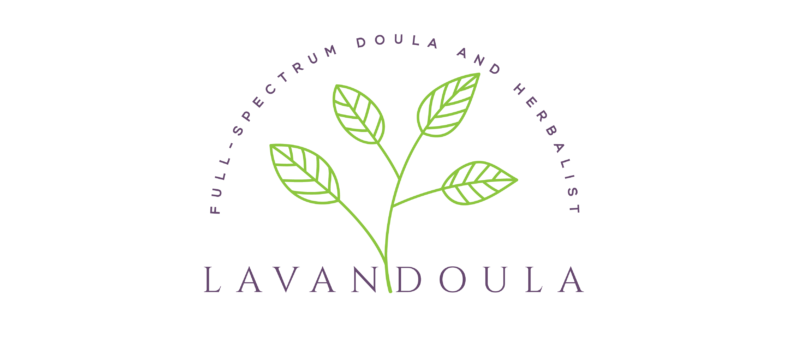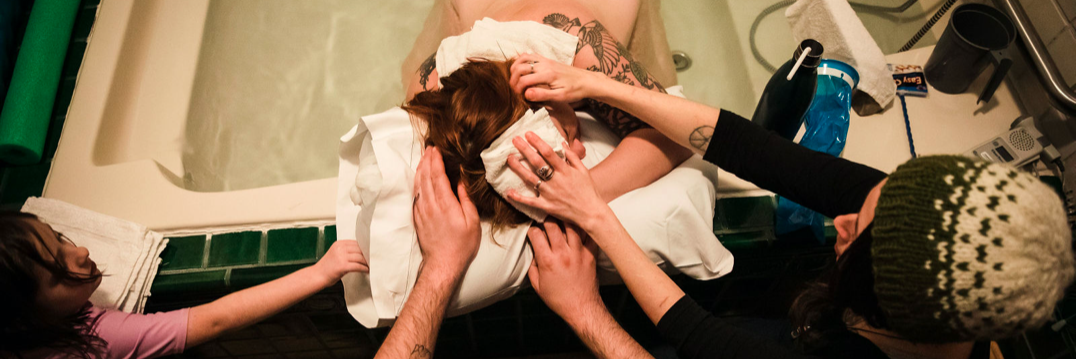Recently, I’ve heard from many clients (and fellow birth workers) about a CDC case of recurrent GBS infection in a newborn whose mother chose to encapsulate and consume her placenta. This rightfully has folks concerned about the process of placenta encapsulation, and curious about the safety of placenta encapsulation in the case of testing positive in pregnancy for Group B Strep.
Here are the highlights of the case, which are important to consider:
- Mom tested negative for GBS at 37 weeks of pregnancy, so was not given the recommended antibiotics in labor for GBS. When given in labor, IV antibiotics quickly cross the placenta. The Evidence Based Birth article states that about 9% of women will test negative but actually be positive during labor (meaning they unknowingly expose their babies to this risk without antibiotics, as the mom in the CDC article did). Also, 16% of women who tested positive will actually be negative during labor, meaning they will receive unnecessary antibiotics.
- Baby was colonized for GBS anyway, needing to spend at least 11 days in the hospital, taking antibiotics. If a baby is born with GBS infection, the hospital should have sent the placenta to pathology to confirm, and then the mother would not have been allowed to release the placenta for encapsulation. This is standard for ANY infection in labor or in the immediate postpartum. I would never process a placenta that was born while an active infection took place in labor, or if a baby had GBS colonization after birth. This is something that all folks who provide placenta encapsulation must check about before moving forward.
- Mom had her placenta encapsulated, method of preparation unknown in this article, and began taking capsules 3 days postpartum
- Baby had recurrent GBS, and was admitted to another hospital 5 days after release from the first
- Mom’s breastmilk tested negative for GBS, but the placenta capsules tested positive
- The CDC case states, “Although transmission from other colonized household members could not be ruled out, the final diagnosis was late-onset GBS disease attributable to high maternal colonization secondary to consumption of GBS-infected placental tissue.”
The doctors came to the conclusion that, because the placenta capsules tested positive for GBS, the mother must have had higher concentrations of the bacteria in her skin or digestive tract, this re-exposing baby to the infection. Group B Strep likes to live in mucous membranes, and there have been a few cases of recurrent GBS that are not-at-all placenta encapsulation related. An adult with an unknown high concentration of GBS could pass it along to a baby with a kiss.
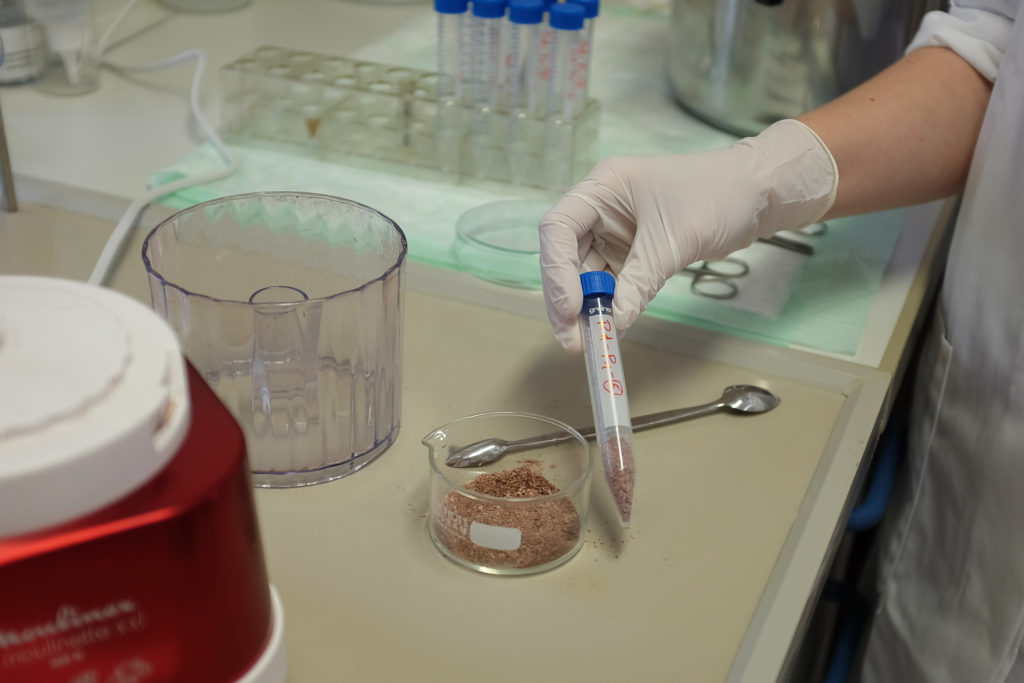 The company this mother used states they dehydrate the placenta for encapsulation between 115 and 160 degrees. In my practice, I dehydrate a steamed placenta at 145 degrees, and a “raw” placenta at 160 degrees Fahrenheit. The protocol I use is the USDA guidelines for safe meat preservation and dehydration. The article also mentions that a temperature of 130 degrees for 121 minutes is long enough to kill salmonella (implying that other bacteria could be significantly reduced in a similar temperature/amount of time). Whenever I process a placenta, I dehydrate it (keeping it between 145 and 160 degrees) for at least 12 hours. Preliminary research shows that steaming the placenta properly and dehydrating it both have a significant impact on reducing potentially harmful bacteria or pathogens. I always use steamed preparation before dehydrating a placenta if my client tests positive for GBS.
The company this mother used states they dehydrate the placenta for encapsulation between 115 and 160 degrees. In my practice, I dehydrate a steamed placenta at 145 degrees, and a “raw” placenta at 160 degrees Fahrenheit. The protocol I use is the USDA guidelines for safe meat preservation and dehydration. The article also mentions that a temperature of 130 degrees for 121 minutes is long enough to kill salmonella (implying that other bacteria could be significantly reduced in a similar temperature/amount of time). Whenever I process a placenta, I dehydrate it (keeping it between 145 and 160 degrees) for at least 12 hours. Preliminary research shows that steaming the placenta properly and dehydrating it both have a significant impact on reducing potentially harmful bacteria or pathogens. I always use steamed preparation before dehydrating a placenta if my client tests positive for GBS.
This article also says the company in Oregon says storing the placenta capsules at room temperature is ok. I definitely recommend refrigerating the capsules to keep them safe for consumption, because unlike other dehydrated/preserved meat products, the placenta capsules contain no sugar, salt or nitrates to preserve them.
Let’s get one more thing straight: GBS is a common bacteria that humans tend to have in their digestive tracts. About 15-30% of folks will test “positive” for a high concentration in the recto/vaginal area during pregnancy. Human bodies are made up of 90% bacteria – 9 out of 10 of our cells are not actually human DNA but bacteria. Folks are just starting to study how bacteria balance in our guts affects health, and how it varies from culture to culture- especially with our current high usage of antibiotics in the US. In the 1970s and 80s, folks realized a large amount of seemingly healthy babies were getting infections after vaginal births (things like pneumonia and other breathing issues – as this baby in the article did suffer), the CDC realized a high concentration of GBS bacteria in the vaginal canal could “colonize” babies on their way out, thus exposing them to the risk of infection. IV antibiotics in labor became the standard of practice, reducing the likelihood of newborns with GBS infections by 80%.
There are some folks studying probiotics and rates of GBS, either orally or topically: yes, the preliminary studies show we can positively impact healthy bacteria balance with probiotic pantyliners. Early research implies that Group B Strep is kept in check with lactobacillus bacteria, and even garlic. Other studies imply that GBS likes to live in a yeast-friendly environment, so folks who are prone to yeast infections might be more likely to test positive in pregnancy. Either way- GBS does impact a lot of my clients. Folks who hope to avoid an IV in labor often need to accept IV antibiotics to reduce the risk of passing GBS to a newborn.
Krystina Fridlander at Baraka Birth has a lovely thorough blog post outlining a lot of the research available on probiotics and Group B Strep. Read more here.
Interview with an Acupuncturist
Last week, I had the pleasure of making a little video interview with local acupuncturist, Angela Bell. She often works with folks who are trying to conceive (including with IVF and other fertility treatments), as well as during pregnancy and generally focuses her practice on women’s health. More about her practice can be found on her Facebook and website.
One thing I so adore about Angela is her desire to connect and highlight others who are birth workers in the Boston area. She holds networking events, and has continued to host a video series on her social media pages for other birth workers to highlight their work. She’s chatted with doulas, massage therapists, midwives, yoga instructors, lactation consultants and others about the work we all do with clients.
In our 30 minute interview, we cover what it means to be a “full-spectrum” doula. I talk about why I decided to become a doula, the work I do with the Boston Doula Project, how others doing this work can best support LGBTQ+ families. We also chat about placenta encapsulation, my practice in Western herbal medicine and what it means to be an advocate for folks in all of this work. If you’re interested to get to know me a little better, check out this video interview!
The Business of Being a Doula
A few folks in my life have recently asked how I feel about the divisive/controversial ProDoula articles that are circulating. Honestly, as someone who chooses not to use any social media, I probably would have missed this entirely if folks didn’t bring it to my attention. I was relatively preoccupied while attending two clients’ 37-week labors, organizing the year’s goals with the steering committee of the Boston Doula Project, and encapsulating another client’s placenta.
Generally, I think there is enough space in Boston (I can’t speak for smaller or more rural communities) for many types of doula practices and their clients. While some doulas have always argued that providing free or very low-cost services devalues doula work as a profession, others continue to provide free or very low-cost services because it is exactly what they are called to do. I absolutely believe folks need to charge a rate for their work that is sustainable to them. On-call support for labor is extremely valuable, and not just because the studies show doulas save thousands of dollars in healthcare costs. We literally prevent trauma (and hold space for trauma that exists) on a regular basis.
The ProDoula founder is right to say that plumbers don’t worry about people who can’t afford to hire plumbers, but birth is not the same as home repairs. Supporting one another in the childbearing year is something that people have always done, and are always going to do. We live in a time and place in human history where folks aren’t all having 15 babies, witnessing 10 younger siblings be born, hanging out around groups who are feeding babies at their chests, and having that community of support built in. We’re giving birth in hospitals, often in big cities far away from family. Most often, the first birth people witness is their own baby’s! We’re needing to pay people out of pocket to create a sense of that lost community support. This used to be culturally built-in, for everyone, for free.
I’m all for folks charging what they need to in order to make their work sustainable – that part’s important and isn’t typically emphasized in many doula trainings. Most doula trainings emphasize what’s normal in birth and postpartum, what’s not, how to be a compassionate and competent helper and how to plug into the extended community of resources for when you need to make referrals. These articles make it sound like ProDoula’s trainings emphasize profits, avoiding the local community (“ProDoula tells doulas to ignore local doula collectives — why fraternize with the competition?”) ostracizing new doulas, and not making referrals because your agency provides The Best And Only care.
- Kara Schamell, at Modern Mama Midwifery has tons of experience, especially in sanitation techniques and lab safety as a midwife. We back up each other’s placenta clients in the case of travel or client birth overlap.
- Jennifer Lynn Frye, at New England Placenta Encapsulation, who has a background in nursing, and has been providing this service since 2014. She was also part of the first-ever batch of Boston Doula Project trainees.
- Jennifer Lewis, at New Life Blessings has encapsulated over 250 placentas in MA, RI and CT.
Placenta Encapsulation FAQ
Here are the answers to some frequently asked questions I receive about placenta encapsulation.
Why would anyone want to eat their placenta? I get this a lot. Usually, I start here: all mammals consume the placenta immediately following the birth, with a few exceptions. These exceptions include whales (who have baleen and generally don’t/can’t eat large pieces of meat), and alpaca-family animals (such as camels). When I asked an alpaca farmer at an agricultural fair why they don’t ingest their placentas, she quickly responded “Their tongues aren’t long enough!” Many domesticated/farm animals have humans who interfere with the postpartum process before they instinctively ingest the placenta. The third exception is humans. While there are a few theories as to why this is, many people are now choosing to consume the placenta in capsule form postpartum. In some circles, it isn’t very popular to consume organ meats, but many folks know they’re some of the most nutrient-dense foods in the world. The placenta contains iron, minerals, high-quality protein as well as hormones (oxytocin, progesterone) that sustained the pregnancy and labor. This helps build parents back up after blood loss, especially if it was more than average. Anecdotally, folks who choose to consume their placenta after birth have fewer bouts of hormone-crashing lows, a strong milk supply, and a little more sustained energy throughout all the sleep depravation.
How many capsules does it yield? Average is about 80-100 capsules. I’ve processed placentas with as few as 53 capsules (when some pieces were saved for Pathology) and as many as 165 capsules. Generally speaking, I’ve found bigger babies have bigger placentas.
How does pickup and drop off work? I’m happy to meet you at your place of birth between 8am and 9pm to pick up your placenta. With some advance notice that you’re in labor (either from you or a partner or doula), I may be able to arrive for pickup quicker. As long as the placenta is kept on ice within two hours after the birth, we should be all set for processing. Processing takes 2-3 days, on my end, and I am happy to return the finished capsules to you when you return home from the hospital.
What if I have medications during labor, or need a cesarian section? That is fine! The medications used during labor generally pass through the placenta or break down quickly. If you had an allergic reaction to any medication given during labor, I would not recommend encapsulation. With a cesarian birth, it is extra important to make sure the placenta is put on ice soon afterward, because everyone tends to be a little busier during that time than with a vaginal birth!
What if I am Group B Strep positive? Group B Strep (GBS) is a normal digestional bacteria that some folks have a high concentration of in the genital area during pregnancy and birth. It is not considered harmful to adult humans (just in rare cases for babies), and I generally recommend steaming the placenta before dehydration for folks who are GBS+.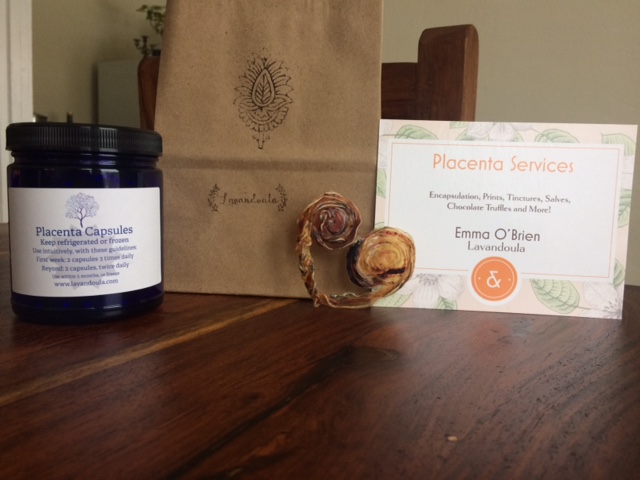
What if there was meconium in labor? Meconium happens! It is sterile and not harmful to adults. Extra nurses will be present at your birth to check out the baby’s lungs and make sure your baby did not aspirate the sticky meconium. Otherwise, meconium washes off the placenta easily during processing and does not contraindicate placenta encapsulation. If there is prolonged exposure to thick meconium, the placenta may look “stained” upon delivery and providers may want to send it to pathology to have it looked at, but that is much less common.
What if my baby is premature? With premature birth, many hospitals will want to send the placenta to pathology to make sure that it wasn’t the cause of a premature birth. In this case, you can advocate for the placenta being kept refrigerated, frozen and chemical-free. The pathologist should be able to remove a few small pieces from the placenta and leave the rest for you to take home, if no problems are found. Keep in mind that hospital pathologists work M-F, 9-5, so this can delay the process, depending on the time you give birth. With any placenta that has been to pathology (even if it is kept separate), I recommend steamed preparation.
How does my birth site impact my decision to keep my placenta for encapsulation? Great question! I always recommend folks talk with their providers about keeping the placenta ahead of time, just to make sure there are no issues. Every birth site (except for homes) will require you sign a placenta release form after the birth before it is able to leave. Certain hospitals have policies that may further impact your experience. For example, Brigham and Women’s Hospital’s policy is to keep the placenta in the hospital until the family and baby are released. They keep it refrigerated for you, but this will delay my ability to process by a few days. Beth Israel Hospital does not let anyone bring the placenta into the postpartum room with them. This means, if you’re hoping to keep your placenta and you’ve given birth in the middle of the night, you need to keep it in a cooler in your car (or have another family member pick it up and bring it to a refrigerator) until I am able to pick it up. Cambridge Birth Center generally releases patients within 6-8 hours after the birth. If you give birth at the birth center, and it is late at night, I may be able to pick up the placenta in the morning from your home. If you have particular questions about the placenta-related policies at your birth site, be sure to ask your provider.
What about payment? My fee for placenta encapsulation is $250. Cash or check are welcome. The fee is due at the time I deliver the finished capsules. In the off chance that you are unable to keep the placenta, I do not require a downpayment.
More to come..!!
An Umbilical Tree
This past week, I was excited to host my friend Anabel, of La Loba Loca, who was in town to facilitate some skillshares at local colleges. Seriously- if you’ve got folks who are interested in sexual health, herbalism, and community-based care, bring her to your community! We met last year at CLPP and, together with others, organized a workshop in Los Angeles this summer.
We realized we were born less than two weeks apart, both cling to yarrow as we meet (and love to meet) TONS of people in our work, shared our 1970’s feminist/herbalist/queer book collections and spun wool together. I also took her to my favorite part of Boston, the Forest Hills Cemetery. We walked around the small chunk of local wilderness behind the gravesite and talked about how we best like to dry out an umbilical cord when preparing the placenta for encapsulation. She knew someone who would tincture the cord, separately, and suggests using it when a birth parent needs to be away from their child. Connection medicine.
Loba and I found this tree and stopped to check it out for a moment.

Next Doula Information Night
Parents in the Boston area should be made aware of Mama and Me, a space that holds events and classes for young families in Jamaica Plain. They offer a range of prenatal, postpartum and child development classes, including some free events!
Upcoming on Wednesday, April 8 from 6-8pm will be their next FREE Doula Information Night. I will be present (if no babies come that night) to meet with expecting parents and chat about my services as a birth and postpartum doula, including placenta encapsulation. Come out and meet the doulas in your community!
PART I: WHAT IS A DOULA? DO I NEED A DOULA? | 6:00-7:00PM
Join other new and expectant parents for a night of FREE education on what a doula is, what a doula does, and how a doulaʼs presence can benefit your birth and help you adjust to life at home with your little one!
PART II: MEET THE DOULAS | 7:00-8:00PM
Doulas from in the Greater Boston Area will be on hand to answer your questions, offer personalized referrals, and represent some of the wonderful variety of personalities, ages, backgrounds, and skills you can find in a birth or postpartum doula. Expectant parents will have time to meet individual doulas and conduct brief interviews with them.
We will answer many common questions birth and postpartum doula services, such as:
What does a doula do?
What do services usually entail?
Why would I want to hire a doula?
How would a doula work with my partner?
How would I go about finding the right doula?
Studies* have shown many benefits of working with a doula, including:
Shorter labors
Fewer requests for epidurals
Less frequent use of forceps or vacuum
Increased confidence in birth partners
Fewer cesareans [OR Lower cesarean rate]
Increased success with breastfeeding
More time to bond with your baby
An easier transition into parenthood
COST: FREE
Placenta Encapsulation: Why the Jalapeños?
In the West, placenta encapsulation is usually performed one of two ways. Either the placenta is sliced and dehydrated raw before grinding into a powder or done the “TCM” way. TCM stands for Traditional Chinese Medicine, and when used to describe placenta preparation, this often means your doula will steam the placenta with lemon, fresh ginger and spicy peppers. The remainder of the process stays the same: powdered placenta is stuffed into capsules for the ingestion of the postpartum mother. Parents frequently ask if I recommend one method of preparation over another. While I do prepare placentas for folks who prefer raw, I tend to stick with the encouragement of cooked foods and warm herbs postpartum.
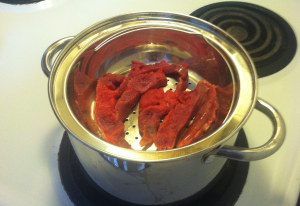
As Jasper Moon at Turning Tides Midwifery blogs, “Traditional Chinese Medicine” preparation of a placenta is anything but traditional. The common recipe for preparing placenta the “TCM way” involves using warming elements, such as lemon, ginger, and hot peppers while steaming the placenta. This recipe was popularized by the Midwives Alliance North America conference in 1984, when Raven Lang presented it. Lang is a self-taught direct-entry midwife from California, pioneer in the midwifery movement in the United States and Traditional Chinese Medicine practitioner.
In TCM, postpartum is considered a very yin or cold time, and steaming the placenta before ingestion with warming herbs fits within that idea to facilitate warmth. This is what qualifies steamed placenta preparation as “traditional.” Jalapeños and lemons are very commonly accessible to midwives and doulas in the West, but I can’t think of an herbalist who considers lemons warming. The placenta has been considered medicinal for purposes in Chinese materia medica, but encapsulation postpartum goes back about thirty years in the U.S.
I wonder why, with few “strict” historical interpretations of placenta preparation postpartum, so many encapsulation specialists stick with the same herbs for steaming. As an herbalist, using “nontraditional” herbs for “Traditional Chinese Medicine” placenta preparation is interesting to me. With knowledge of our particular client’s concerns, we can be empowered to make more educated choices about our use of herbs.
This June, I prepared chocolate placenta truffles for a first time mom. While raw honey, coconut oil, and dried cherries appealed to mom, I chose to steam her placenta with cloves, cinnamon, nutmeg and ginger. These are all herbs that are considered warming, gently stimulating and are pleasantly fragrant to work with.
